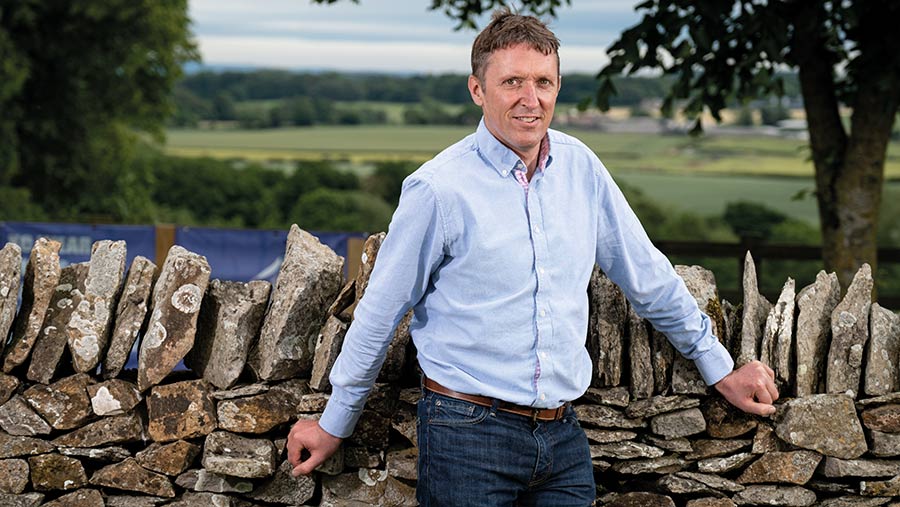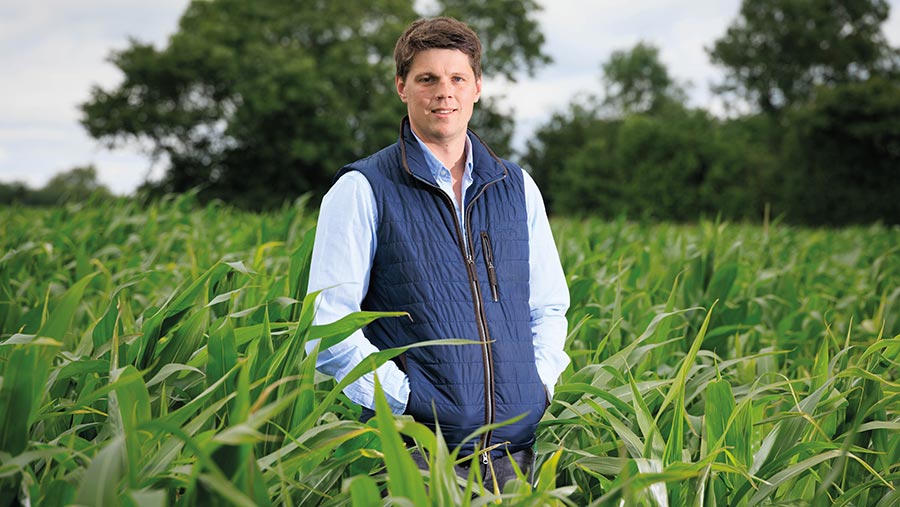Farmers Weekly Awards 2022: Arable Farmer of the Year finalists

All three finalists for the Farmers Weekly Arable Farmer of the Year award are finding different ways to put organic matter back into the soils on their family farms.
See also: Farmers Weekly Awards 2022: Poultry Farmer of the Year finalists
The finalists:
Philip Metcalfe
Foxberry Farm, North Yorkshire
Will Oliver
Swepstone Fields Farm, Leicestershire
Graham Potter
The Grange, North Yorkshire
The judges:
Simon Best
Last year’s winner
Richard Allison
Farmers Weekly arable editor
Damion McAuley
Independent judge and AICC agronomist
Philip Metcalfe
Foxberry Farm, North Yorkshire

Philip Metcalfe © Jim Varney
With wheat averaging 11.4t/ha and beans at 6.6t/ha last season, Philip Metcalfe’s crops certainly stand out in an area that gets more than its fair share of challenging weather.
A focus on costs, creating new added-value markets and getting muck back onto the farm have resulted in a profitable arable business on the family’s ex-dairy farm.
And Philip has achieved this while fighting his own personal battle with multiple sclerosis (MS). His disability hasn’t stopped him – in fact, he saw it as a massive management opportunity to drive the business forward.
The challenge
The former dairy farm on the County Durham border hasn’t seen cattle since Philip’s dad took a golden handshake to leave the sector in the 1970s. Since then, crops were the focus.
However, he recalls that his neighbour still had cattle, and also had some of the best crops in the area. So when he returned home from college and took over in 2001, he knew muck was the way forward.
In addition, he was diagnosed with MS in 2010, so over the past 12 years he has had to reduce his day-to-day hands-on role.
It meant the farm would have to carry the extra labour requirement, so he needed to make the business leaner, as well as find additional income streams.
The journey
He made radical changes to the business, widening the rotation from three to six crops; winter barley, spring barley, oilseed rape, wheat, winter beans and potatoes. Stewardship and grass are also in the mix.
Philip has brought muck back on the farm in the form of chicken manure from a neighbouring farmer, applied ahead of oilseed rape and spring barley, plus straw-for-muck deals.
He also switched from a ploughing to no-inversion min-till on his sandy, clay loam to cut fuel use and improve soil health.
He has turned his disability into a positive by investing time in managing the business, scrutinising costs and finding new opportunities to add value to crops and generate new income streams.
The journey has been aided by joining a local AHDB benchmarking group, comparing costs and sharing ideas.
The results
The result is that he has a well-managed business that is delivering impressive margins and crop yields. For example, his first wheat from harvest 2021 is generating a gross margin of £2,298/ha, while the oilseed rape margin is even higher.
His drive on costs is impressive – for example, the cost of production for first wheat is £85.78/t.
By buying inputs himself, he is saving 20% on some, and he has slashed labour and machinery spend by collaborating with neighbouring farmers – he has a baling contracting venture plus a neighbour harvests his crops.
Soil organic matters have increased to 4.5-5.5% and poultry manure is enabling him to trim nitrogen fertiliser rates.
An application rate of 7.5t/ha provides 30% of the oilseed rape N requirement and half of the spring barley needs, representing a saving of £100/ha for both crops at today’s prices.
A home-made fertiliser plant is driving nitrogen fertiliser costs down further, buying in distressed urea and turning it into liquid fertiliser.
He is adding value to cereals with a roller mill, selling directly to local beef and sheep farmers. Being in the North, drying costs are higher, so Philip is now looking at wholecropping winter beans to supply a local beef farmer.
Winter wheat is also grown for seed, while his spring barley is grown under the AB14 low-input cereal stewardship option.
In conclusion, Philip has transformed the family farm and, thanks to the return of muck, he now has some of the best crops in the area.
What the judges say
“Philip has built a profitable business by managing costs and developing new markets for added-value cereals. His well-run business is producing exceptional crops that are delivering impressive margins.”
Philip Metcalfe summary
The judges liked
- Excellent-looking crops and gross margins
- Well-run arable business
- Adding value with processed cereals
- Fertiliser mixing plant
- Successful collaboration with neighbouring farmers
Farm facts
- Area 191ha with 170ha arable cropping
- Cropping Includes winter barley, spring barley, oilseed rape, wheat, winter beans and potatoes
- Establishment Based on 2.5m Flatlift cultivator and 4m Amazone combi drill. Plough before barley
- Soils Sandy, clay loam
- Staff Philip plus one full-time staff member
The numbers
- 11.4 Average wheat yield (t/ha) for harvest 2021
- 100 Saving (£/ha) in fertiliser N (kg/ha) from a 7.5t/ha application of poultry litter
- 20 Reduction (%) in some inputs since doing own buying
- 4.5 Area of tree planting (ha) along watercourse
- 100 Proportion (%) of water for spray mixes and liquid fertiliser that is rainwater
- 85.78 Cost of production (£/t) excluding rent and finance for winter wheat for harvest 2021
Will Oliver
Swepstone Fields Farm, Leicestershire

Will Oliver © Tim Scrivener
Investing £3.6m in a 200,000-bird broiler business seems a radical way to increase soil organic matter on arable land, but that is what Will Oliver did after returning home from university.
It was the start of his organic manures journey, culminating in a cropping system that extracts the maximum value from them.
Soils are healthier, crop yields have risen and the farm’s reliance on artificial fertiliser has been slashed.
This, combined with Will’s ruthless focus on cost of production rather than yields, means the family arable business is delivering impressive margins.
The challenge
The family farm used to have a mix of arable, dairy, beef and sheep. Over the years, it transformed into a specialist arable business, with beef being the last to go in the early 2000s.
Over the next 15 years, it felt like “take, take from our soils”, says Will.
So, after returning from Harper Adams, Will wanted to take the family farm to the next level and relished the challenge of doing his own agronomy.
The family business was also facing other challenges. Oilseed rape was no longer the big earner due to cabbage stem flea beetle damage and high erucic acid levels, and there was also a worsening blackgrass problem.
Ultimately, the family farm needed to become more resilient to withstand new challenges, such as the rising input costs seen in recent months.
The journey
To solve the manure problem, the family invested in a 200,000-bird broiler unit, with the litter and digestate applied in spring on wheat and sewage sludge before maize.
Other soil measures include cover cropping and less intensive cultivations.
Second wheat and oilseed rape has been dropped from the rotation and grain maize has joined winter wheat, winter beans and land rented out for potatoes.
Introducing maize has also enabled Will to make the most of organic manures, and soils benefit from the crop residue.
Finally, doing his own agronomy and his extensive use of precision tools is helping him to slash inputs and drive up crop efficiency.
He is also taking a zero-tolerance approach to blackgrass, spraying out bad areas and using spring cropping (maize and potatoes) and delayed wheat drilling.
The results
Will is seeing real benefits from his manure journey, with soil health improving. Organic matter has increased from 3.2% to 4.8% over the past four years.
He strives to get the most from organic manures and the broiler unit is now providing the arable farm with £113,760 worth of nutrients (NPK using RB209 nutrient availability). Precision tools, such as mapping and a hand-held sensor, are also helping Will to hone fertiliser inputs.
In total, he managed to save more than £100,000 in fertiliser last year. Poultry litter is not only saving money, but he has also seen a 0.9t/ha lift in wheat yield.
His focus on costs rather than yield is paying off with impressive costs of production and gross margins. For example, his wheat varieties range from the cheapest, Skyfall at £33.29/t, to £48.77/t for Belepi.
Will has seen success with grain maize, a profitable break crop with returns equivalent to milling wheat. Maize also has a good rotational fit, providing blackgrass benefits and using organic manures plus good crop residue.
He has diversified the business and champions farming with the environment, with his farm sequestering 31,000t of carbon/year.
But it’s his manure journey that stands out, taking organic nutrient inputs to the next level. This is evident with the big heap of fertiliser unused this season.
What the judges say
“Will has excellent attention to detail and grasp of the figures. He is making the most of manures and has made a success of grain maize in a profitable rotation. He has taken his business to the next level.”
Will Oliver summary
The judges liked
- Attention to detail and data knowledge
- Making grain maize a success
- Doing own agronomy and good technical knowledge
- Willing to try new things
- Excellent use of organic manures
Farm facts
- Area 850ha
- Cropping Includes winter wheat, grain maize, winter beans, potatoes and countryside stewardship
- Establishment Based on 12m Horsch Sprinter tine drill with 6m Amazone combi drill as backup
- Soils Mainly clay/loam with some lighter land
- Staff Two full-time on the arable side
The numbers
- 7.03 Cost (£/ha) for precision tools (Rhiza, Gatekeeper, Yagro, Gatekeeper), and information (Niab, Maize Growers Association, AICC)
- 4.9 Average soil organic matter content (%). This is up from 3.2% four years ago
- 2,000 Total amount (t/year) of poultry litter from the broiler unit
- 110 Amount (t) of grain maize that can be dried in a day
- 101,600 Saving (£) in fertiliser last year using organic manures
- 0.91 Increase in wheat yield (t/ha) with poultry litter
Graham Potter
The Grange, North Yorkshire

Graham Potter © Jim Varney
Becoming carbon neutral within the next five years is Graham Potter’s vision and he has already taken massive steps towards this goal on his arable farm, next to the River Swale.
His crop inputs have fallen through a combination of nursing soils back into good health and adopting the latest precision farming technology.
It’s a huge achievement given that his soils were “dead” 13 years ago, and he is now inspiring other Yorkshire farmers to start their own low carbon journey.
The challenge
Back in 2009, Graham took over from his dad, with the farm using a traditional plough-based system.
Like many in the area, the mixed farm specialised in arable cropping, with the livestock sold off. The farm prospered at first.
However, he recalls reaching a turning point when some soil samples came back at only 1% organic matter and he realised that they were dead.
“You could smell it. It didn’t have that sweet smell that you get with healthy soils,” he says.
Having spent several years on a farm in Western Australia, Graham saw first-hand how soils benefited from precision agronomy, direct-drilling and a greater focus on soil health.
So he decided to recreate this Australian approach back in North Yorkshire.
The journey
His first challenge was to find a way to increase soil organic matter without having livestock.
He opted for cover cropping and chopping straw, as it was too risky to bring manure into their blackgrass-free farm. His concerns about heavy metal loading also ruled out the use of sewage sludge.
He reduced cultivations by switching to a Claydon direct-drilling system and adopting a controlled traffic farming system with RTK guidance enabling permanent tramlines for tractors, sprayers and the combine to travel on, to minimise compaction.
Graham is an early adopter of precision technology and he is making better use of crop inputs, applying them where they are needed most. This is especially valuable on his very variable soils, with some fields going from blowing sand to heavy clay.
A focus on selling wheat directly to local feed mills is keeping miles down, and he joined the Sustainable Landscapes initiative to share ideas and start his low-carbon journey.
The results
Soil organic matters are now averaging 5.6% – some fields were as low as 1% when he started. This has been achieved without using any manure, compost or sewage sludge. “Soils now smell sweet,” he says.
Healthy soils mean he is able to reduce inputs, and he has cut nitrogen fertiliser use with first wheat from 205kg/ha to 188kg/ha and spring barley from 105kg/ha to 90kg/ha. He is also looking at reducing it even more.
This has all been achieved with little effect on yields, with first wheat averaging 11t/ha. He is also successfully managing flea beetle in oilseed rape, which is averaging 4.5t/ha, while his neighbours are seeing crop failures.
However, the star crop for Graham is carbon-neutral malting barley for Heineken, which is malted at Bridlington and brewed in Tadcaster.
This can be the most challenging crop to grow in a direct-drill system, but he is seeing success with his approach to slugs and cover crops.
The net-zero barley contract is through the Sustainable Landscapes initiative, where he is a host farmer spearheading efforts to improve water quality by adopting practices such as cover cropping.
And his passion to share knowledge is seeing other Yorkshire farmers take the first steps on their low-carbon farming journey.
To conclude, in this corner of Yorkshire, Graham is leading the way, showing what a low-carbon cropping system looks like.
What the judges say
“Graham shows huge passion for improving soil health and has successfully added soil organic matter without having any livestock. He is making good use of technology and is engaged with local farmers and schools.”
Graham Potter summary
The judges liked
- Good soil management and use of cover crops
- Passion for using technology and data
- Proactive slug control regime
- Working with Yorkshire Water and Heineken
- Home-made grain-drying app
Farm facts
- Area 200ha of arable cropping
- Cropping Includes wheat, spring malting barley and oilseed rape
- Establishment Based on 4.8m Claydon drill
- Soils Very variable, ranging from light sand to clay
- Staff Graham, his nephew, who also does contract drilling, plus harvest help. Graham also does contract harvesting
The numbers
- 5.6 Average soil organic matter content (%)
- 188 Current nitrogen fertiliser rate (kg/ha) for first wheat
- 11 Average wheat yield (t/ha) at The Grange
- 4.5 Average OSR yield (t/ha) at The Grange
- 115 This year’s bonus (£/t) for growing high-erucic acid oilseed rape
- 50,000 Investment (£) in precision technology over past 10 years
Sponsor’s message
 Fendt is pleased to be sponsoring the Arable Farmer of the Year award once again. Congratulations to the three finalists, all of whom demonstrate an adaptable and resilient approach to farming in these challenging times. ”
Fendt is pleased to be sponsoring the Arable Farmer of the Year award once again. Congratulations to the three finalists, all of whom demonstrate an adaptable and resilient approach to farming in these challenging times. ”
Ed Dennett, Fendt Sales and Marketing

